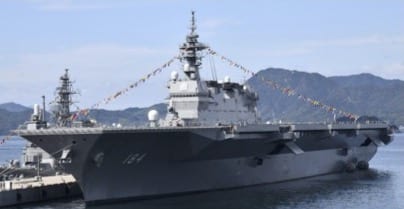TOKYO: Japan is in the midst of a rearmament programme unprecedented since World War II. Defence spending is being doubled, and is expected to reach 2% of gross domestic product within five years.
Why is this happening? Because Japan is alarmed by China’s far greater military buildup—particularly in sea power– and by nearby North Korea’s stepped-up missile launches perilously close to Japan’s home islands.
The escalating military threat from hostile neighbours appears to have accomplished what decades of internal debate could not—the rolling back of deeply entrenched pacifism, the result of Japan enduring two atomic strikes and defeat in the second world war.
The government’s December 16 2022 white paper offers a sober analysis of Japan’s position in East Asia. It argues that Japan faces its ‘most severe and complex security environment since the end of World War II.’ Referring to China’s threat to Taiwan, it cites growing pressure ‘by those seeking to unilaterally change the status quo by force.’
Not surprisingly China has denounced the Japanese white paper, saying Beijing firmly opposes Tokyo’s defence buildup.
The US is applauding the defence plan that elevates Japan towards full partnership with the Americans in regional security. National security advisor Jake Sullivan calls Prime Minister Fumio Kishida’s programme a ‘bold and historic step’ that promotes regional stability and ‘strengthens and modernizes the US-Japan alliance.’ Since 1945, Japan has depended on the United States for defence. Over 30,000 US military personnel are posted at multiple US bases in Japan.
Evidence of Japan’s strategic shift are two aircraft carriers, the biggest naval ships built in post-war Japan. Initially called ‘multi-purpose destroyers,’ the vessels have been modified to accommodate US-made F-35 fighters. The ships rival in size the carriers Japan deployed in World War II.

Yoichi Funabashi, among the most respected of Japanese commentators, recently wrote in support of the defence buildup, arguing that ‘maintaining or expanding deterrent power is essential to keeping the peace. This means that one must continually prepare for war in order to avoid one.’
Funabashi calls for a tightening of the US-Japan military alliance. ‘It is imperative,’ he argues, ‘that Japan clarify with the U.S. their division of roles and mutually complementary functions, improve interoperability and share strategies.’
It was former prime minister Shinzo Abe – tragically assassinated last July – who persistently advocated that Japan move beyond its post-war pacifism. Prime minister twice, in 2006/2007 and again from 2012 to 2020, Abe was instrumental in the formation of the Quad, the quadrilateral security dialogue comprising the US, Japan, India and Australia – to counter rising Chinese influence in the Indo-Pacific region. Quad summits occurred in 2021 and 2022.
Japan’s strategic priority is protection of vital shipping lanes in the South China Sea that connect Europe with East Asia and through which pass essential oil imports and a huge volume of trade. The vast 5,000km-long corridor extends from Singapore, threads between the Philippines and mainland China and then past Taiwan to Japan. Okinawa, the southern-most Japanese island, is closer to Taipei than Tokyo.
In relations with China, Japan balances geo-political considerations with commercial interests. Since 2007 China has been Japan’s biggest trading partner. Japan’s most successful companies have manufacturing operations in China. However, in high technology goods like semiconductors, Japanese firms have embraced the export restrictions promulgated by Washington.
Still the world’s third biggest economy (after the US and China), Japan in recent decades has been overshadowed by the rise of China. But Japan remains the most important US ally in east Asia.
Indeed, much of Japan’s rise in the 1960s and 1970s can be traced to the far-reaching reforms put in place during the American occupation in the late 1940s. American diplomat and scholar Edwin Reischauer wrote that the United States was a ‘revolutionary force’ in Japan, ensuring democracy, women’s rights, land reform, the break-up of corporate monopolies, and the emperor’s public denial of divinity. Japan today is a vibrant parliamentary democracy.
American General Douglas MacArthur headed the post-World War II occupation and under his guidance the Japanese constitution was revised to include the reforms enumerated above.
The most controversial provision in the 1947 constitution is article nine, which states, ‘the Japanese people forever renounce war as a sovereign right of the nation and the threat or use of force as a means of settling international disputes.’
It further states that ‘land, sea, and air forces, as well as another war potential, will never be maintained.’
Beginning in 2015, then prime minister Abe advocated a reinterpretation of article nine to counter the rising threat from China. In his memoir General MacArthur wrote that the no-war clause could not ‘be interpreted as complete negation of the inalienable right of self-defense…’.
Rahm Emanuel, US ambassador to Japan, says China wants to push the United States out of the Asia Pacific. That won’t happen, he says, because the ‘US is a permanent presence in the region’. Japan’s military expansion, says Emanuel, ‘ushers in a new era’ of heightened cooperation between the U.S. and its allies in the region.
The views of the writer are not necessarily the views of the Daily Friend or the IRR.
If you like what you have just read, support the Daily Friend.

